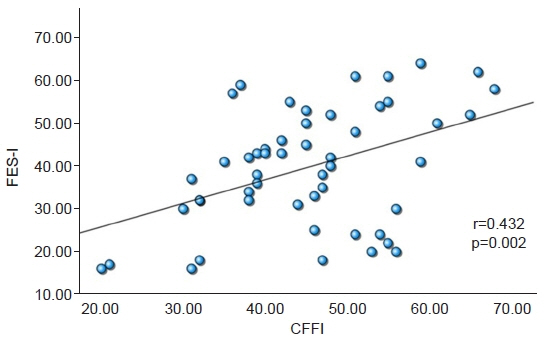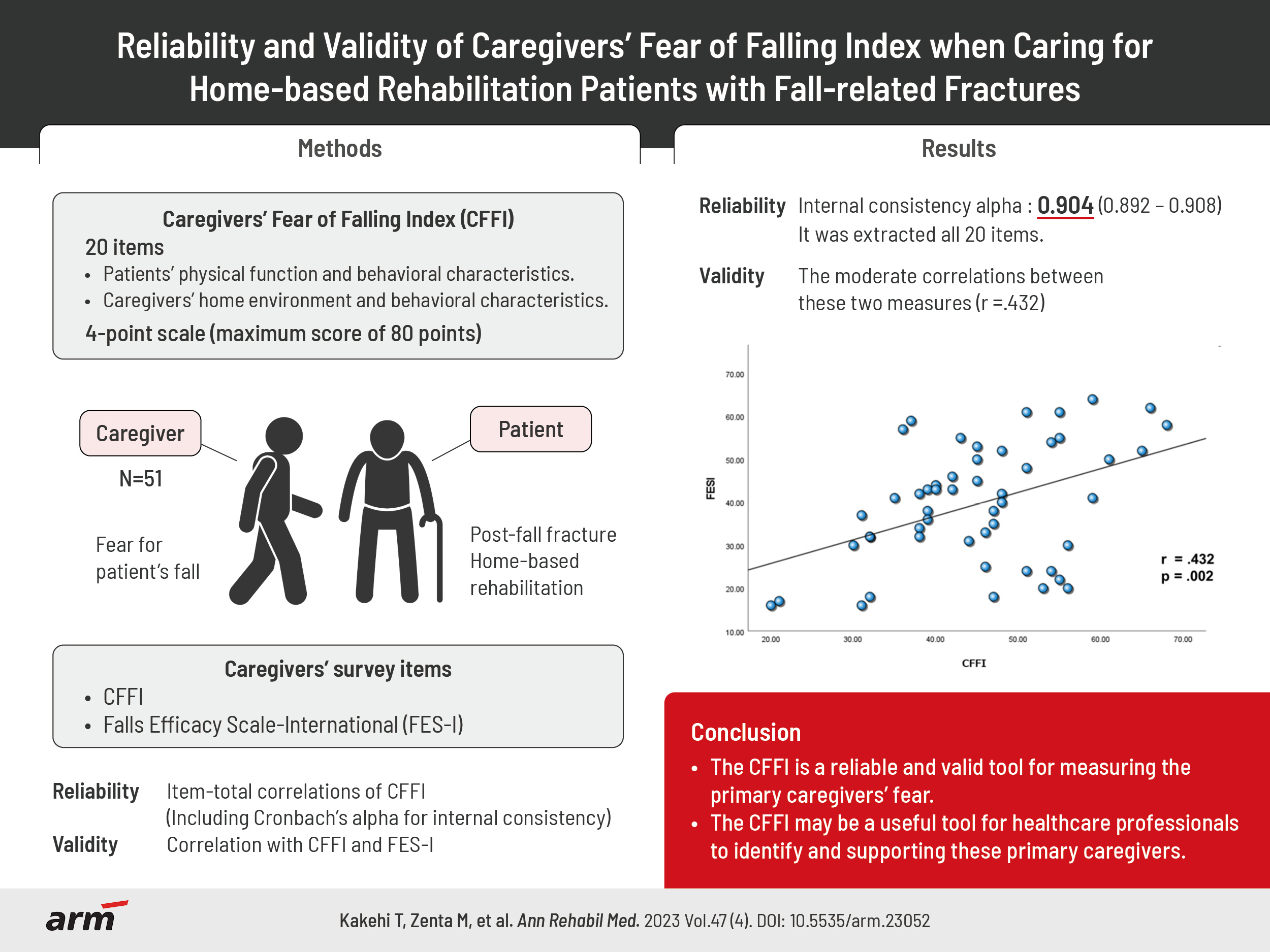Ann Rehabil Med.
2023 Aug;47(4):300-306. 10.5535/arm.23052.
Reliability and Validity of Caregivers’ Fear of Falling Index When Caring for Home-Based Rehabilitation Patients With Fall-Related Fractures
- Affiliations
-
- 1Department of Rehabilitation Medicine, Graduate School of Medicine, International University of Health and Welfare, Narita, Japan
- 2Department of Occupational Therapy, School of Health and Sciences at Narita, International University of Health and Welfare, Narita, Japan
- 3Division of Rehabilitation Medicine, International University of Health and Welfare Ichikawa Hospital, Ichikawa, Japan
- 4Department of Rehabilitation, Institute of Brain and Blood Vessels, Mihara Memorial Hospital, Isesaki, Japan
- 5Rehabilitation Center, Ushiku Aiwa General Hospital, Ushiku, Japan
- 6A Home-Visit Nursing Station of Ryugasaki, Ryugasaki, Japan
- 7Department of Orthopaedic Surgery, International University of Health and Welfare Ichikawa Hospital, Ichikawa, Japan
- 8Department of Orthopaedic Surgery, School of Medicine, International University of Health and Welfare, Narita, Japan
- KMID: 2545326
- DOI: http://doi.org/10.5535/arm.23052
Abstract
Objective
To evaluate the reliability and validity of this new measure, called the caregivers’ fear of falling index (CFFI).
Methods
The study surveyed home-based rehabilitation patients with fall-related fracture, and their primary caregivers. The characteristics of these patients were evaluated, and the caregivers were surveyed using the CFFI and Falls Efficacy Scale-International (FES-I). The reliability of the CFFI was assessed using item-total correlation, while the validity of the CFFI was evaluated through correlation coefficients calculated between the CFFI and the FES-I.
Results
The participants were 51 patient-caregiver pairs. The internal consistency of the CFFI showed an alpha coefficient of 0.904. No items were excluded in the corrected item-total correlations. The CFFI showed a moderate correlation with FES-I (r=0.432, p=0.002).
Conclusion
This study found the CFFI to be a reliable and valid tool for measuring the primary caregivers’ fear. The CFFI may be a useful tool for healthcare professionals to identify and supporting these primary caregivers.
Figure
Reference
-
1. Scheffer AC, Schuurmans MJ, van Dijk N, van der Hooft T, de Rooij SE. Fear of falling: measurement strategy, prevalence, risk factors and consequences among older persons. Age Ageing. 2008; 37:19–24.2. Tomita Y, Arima K, Kanagae M, Okabe T, Mizukami S, Nishimura T, et al. Association of physical performance and pain with fear of falling among community-dwelling Japanese women aged 65 years and older. Medicine (Baltimore). 2015; 94:e1449.3. Kim S, So WY. Prevalence and correlates of fear of falling in Korean community-dwelling elderly subjects. Exp Gerontol. 2013; 48:1323–8.4. Chu CL, Liang CK, Chow PC, Lin YT, Tang KY, Chou MY, et al. Fear of falling (FF): psychosocial and physical factors among institutionalized older Chinese men in Taiwan. Arch Gerontol Geriatr. 2011; 53:e232–6.5. Ayoubi F, Launay CP, Kabeshova A, Fantino B, Annweiler C, Beauchet O. The influence of fear of falling on gait variability: results from a large elderly population-based cross-sectional study. J Neuroeng Rehabil. 2014; 11:128.
Article6. Uemura K, Yamada M, Nagai K, Tanaka B, Mori S, Ichihashi N. Fear of falling is associated with prolonged anticipatory postural adjustment during gait initiation under dual-task conditions in older adults. Gait Posture. 2012; 35:282–6.
Article7. Donoghue OA, Cronin H, Savva GM, O'Regan C, Kenny RA. Effects of fear of falling and activity restriction on normal and dual task walking in community dwelling older adults. Gait Posture. 2013; 38:120–4.
Article8. Friedman SM, Munoz B, West SK, Rubin GS, Fried LP. Falls and fear of falling: which comes first? A longitudinal prediction model suggests strategies for primary and secondary prevention. J Am Geriatr Soc. 2002; 50:1329–35.
Article9. Visschedijk J, van Balen R, Hertogh C, Achterberg W. Fear of falling in patients with hip fractures: prevalence and related psychological factors. J Am Med Dir Assoc. 2013; 14:218–20.
Article10. Ingemarsson AH, Frändin K, Hellström K, Rundgren A. Balance function and fall-related efficacy in patients with newly operated hip fracture. Clin Rehabil. 2000; 14:497–505.
Article11. Oude Voshaar RC, Banerjee S, Horan M, Baldwin R, Pendleton N, Proctor R, et al. Fear of falling more important than pain and depression for functional recovery after surgery for hip fracture in older people. Psychol Med. 2006; 36:1635–45.
Article12. Kusaba T, Sato K, Fukuma S, Yamada Y, Matsui Y, Matsuda S, et al. Influence of family dynamics on burden among family caregivers in aging Japan. Fam Pract. 2016; 33:466–70.
Article13. Shen J, Hu F, Liu F, Tong P. Functional restriction for the fear of falling in family caregivers. Medicine (Baltimore). 2015; 94:e1090.
Article14. Kuzuya M, Masuda Y, Hirakawa Y, Iwata M, Enoki H, Hasegawa J, et al. Falls of the elderly are associated with burden of caregivers in the community. Int J Geriatr Psychiatry. 2006; 21:740–5.
Article15. Kakehi T, Tamura N, Zenta M, Suzuki Y, Nakajima K, Wada H, et al. Proposal of index to evaluate caregivers' fear of care recipient falls. Int J Rehabil Res. 2022; 45:366–9.
Article16. Yardley L, Beyer N, Hauer K, Kempen G, Piot-Ziegler C, Todd C. Development and initial validation of the Falls Efficacy Scale-International (FES-I). Age Ageing. 2005; 34:614–9.
Article17. Bonett DG. Sample size requirements for testing and estimating coefficient alpha. J Educ Behav Stat. 2002; 27:335–40.
Article18. Fujiwara Y, Suzuki H, Yasunaga M, Sugiyama M, Ijuin M, Sakuma N, et al. Brief screening tool for mild cognitive impairment in older Japanese: validation of the Japanese version of the Montreal Cognitive Assessment. Geriatr Gerontol Int. 2010; 10:225–32.
Article19. Veronese N, Bolzetta F, Toffanello ED, Zambon S, De Rui M, Perissinotto E, et al. Association between Short Physical Performance Battery and falls in older people: the Progetto Veneto Anziani Study. Rejuvenation Res. 2014; 17:276–84.
Article20. Zijlmans EAO, Tijmstra J, van der Ark LA, Sijtsma K. Item-score reliability as a selection tool in test construction. Front Psychol. 2019; 9:2298.
Article21. Streiner DL, Norman GR. Health measurement scales: a practical guide to their development and use. 2nd ed. Oxford University Press;1995.22. Segev-Jacubovski O, Herman T, Yogev-Seligmann G, Mirelman A, Giladi N, Hausdorff JM. The interplay between gait, falls and cognition: can cognitive therapy reduce fall risk? Expert Rev Neurother. 2011; 11:1057–75.
Article23. Cheng HY, Chair SY, Chau JPC. Effectiveness of a strength-oriented psychoeducation on caregiving competence, problem-solving abilities, psychosocial outcomes and physical health among family caregiver of stroke survivors: a randomised controlled trial. Int J Nurs Stud. 2018; 87:84–93.
Article
- Full Text Links
- Actions
-
Cited
- CITED
-
- Close
- Share
- Similar articles
-
- The Validity and Reliability of Korean Fall Efficacy Scale(FES) and Activities-specific Balance Confidence Scale(ABC)
- Factors Associated with the Fear of Falling after Discharge in Older Adults Who had Surgery after Experiencing a Fall Fracture
- Correlation Between Pain, Fear of Falling and Disability in Low Back Pain
- Fear of Falling, ADL and Physical Functioning among Senior Citizens
- Fear of Falling and Related Factors in Elderly Living Alone Based on Fall Experience




